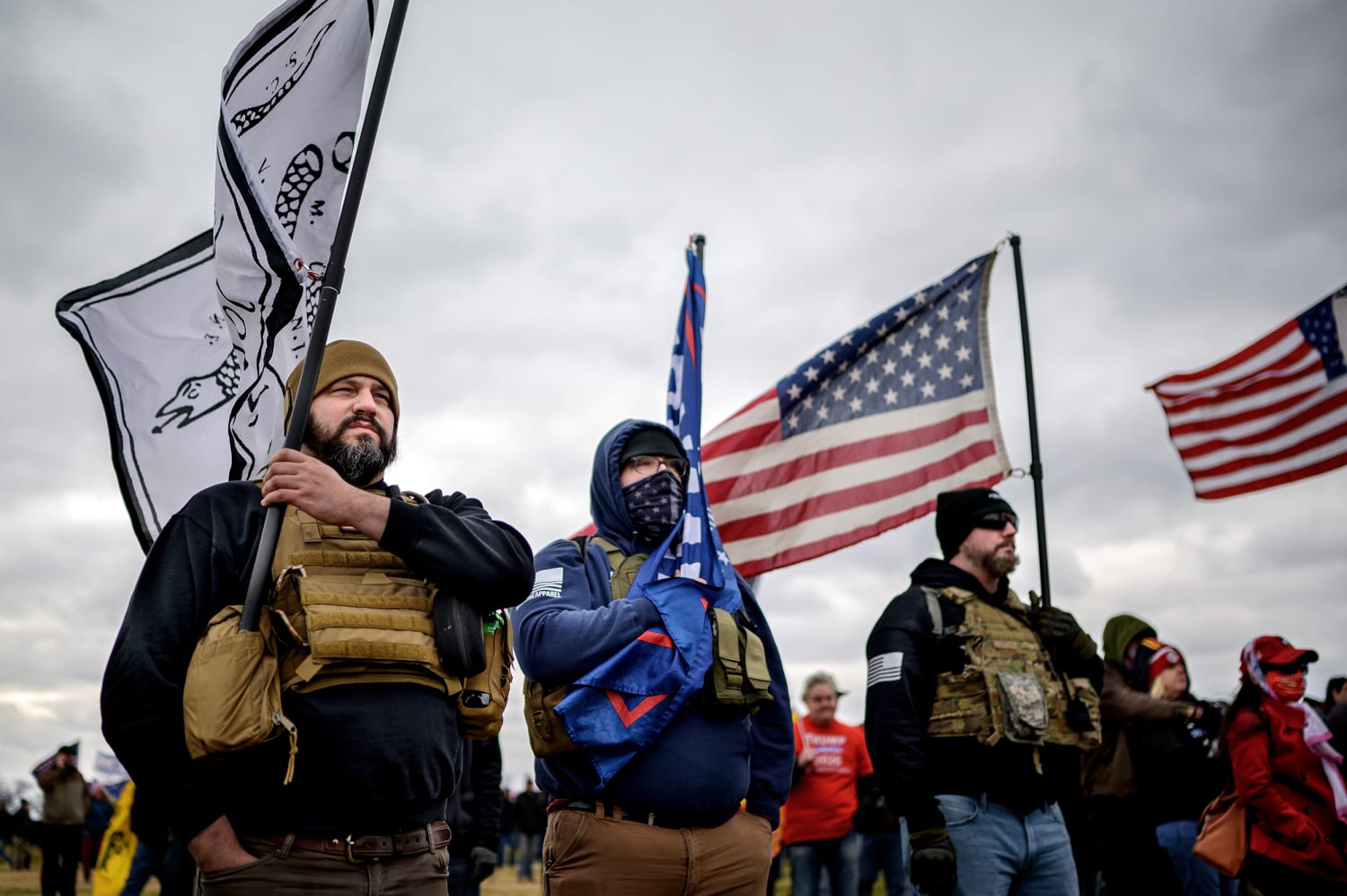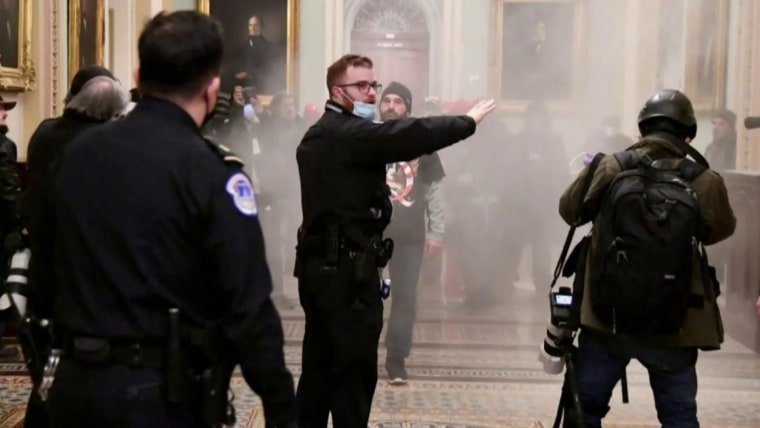The country watched in disbelief as far-right protesters stormed the U.S. Capitol on Wednesday, brandishing Confederate battle flags and sending senators and representatives fleeing for safety. A violent coterie of Trump supporters smashed windows and staged an occupation of Congress, all to halt the counting of Electoral College votes, as is required by the Constitution. President Donald Trump, for his part, did little to slow the violence, tweeting out attacks on his vice president and repeating his claims about election fraud, illegitimacy and conspiracy.
It’s not like we weren’t warned. In the days leading up to the rally, online forums popular with the far right were filled with threats of violence.
“We will never give up. We will never concede. It doesn’t happen. You don’t concede when there is theft involved,” Trump told cheering crowds at the “Save America March,” shortly before the riot began. Before it was over, one woman would be fatally shot, more people would be injured, and the world would be left in shock. But while people living outside the U.S. might have reason to be surprised by the images beamed around the globe, Americans — especially Republicans — should have seen this crisis coming.
It’s not like we weren’t warned. In the days leading up to the rally, online forums popular with the far right were filled with threats of violence. Such rhetoric dovetails with the actions of far-right vigilantes and alt-right gangs like the Proud Boys. On the eve of the rally, the leader of the Proud Boys, Enrique Tarrio, was arrested and accused of destroying a Black Lives Matter sign at a historic Black church at a previous pro-Trump rally.
These groups haven’t been hiding their weapons, their aggression or their intent to cause injury and mayhem, with Black Lives Matter supporters often bearing the brunt of the violence. According to researcher Ari Weil, there were over 100 car attacks on demonstrators against police brutality from May to September. At the Aug. 22 “Back the Blue” rally in Portland, Oregon, armed “militia” members assaulted protesters. Vigilantes patrolled the streets in Philadelphia in early June, attacking protesters and reporters with baseball bats.
2020 also saw the rise of the “boogaloo movement,” a far-right militia culture bent on instigating a second Civil War, which has instigated multiple killings and attacks. Conspiracy theories about secret elites seem to have been a motivating factor in the Christmas Day bombing in Nashville, Tennessee. Theories like QAnon, which have been tied to numerous acts of violence and terrorism plots, are moving into mainstream discourse in the Republican Party (and even into the halls of Congress).
In the weeks since President-elect Joe Biden’s win, Trump has continued to argue that a conspiratorial cabal has denied him a second term. This insistence has led to dozens of armed rallies. One such rally in Olympia, Washington, last month involved multiple shootings; four people were stabbed and dozens more were arrested at an event Dec. 12 in Washington, D.C.
Wednesday’s march was marketed as a sort of “last stand” against the incoming Biden administration. Satellite protests coincided around the country; in Salem, Oregon, armed Trump supporters fought with police at the state capital for the second time in less than three weeks.
Trump’s claims that the election was rigged have only added to the conspiratorial thinking of these groups, a development with dangerous consequences. No longer relegated to far-flung corners of the internet, this collective descent into conspiratorial thinking is what some researchers of the far right, such as Georgetown Law professor Mary McCord, are calling a “mass radicalization” episode. If the “elites” are willing to steal the election (or invent a virus), why engage in aboveground electoral politics at all? Why not just take up arms, storm government buildings and try to overthrow democracy itself?
Conspiracies lead to acts of violence because they infect people with the belief that they are heroes destined to stop profound acts of evil that less enlightened citizens can’ot see. But seeing satanic cabals of pedophiles around every corner creates a distinctly unpleasant emotional state. “It’s like they’re virtually traumatizing themselves. It’s like they’re inventing stories, experiencing those stories, and then living through the vicarious trauma of the stories,” said Sarah Hightower, an expert on the QAnon conspiracy theory culture.
We now live in a bifurcated reality, where more than 75 percent of Republicans (which translates to tens of millions of people) believe the election could be fraudulent, a belief that requires a tacit commitment to conspiracies. Tens of millions of people believe that the world is not as we see it but that, instead, a shadow class is pulling the strings.
Indeed, despite indisputable evidence that it was far-right supporters of Trump who stormed the Capitol, conservative activists have already begun spinning an alternative version of events, in which it was really anti-fascist activists who wreaked havoc. “Do not be surprised if we learn in the days ahead that the Trump rioters were infiltrated by leftist extremists,” Fox News’ Brit Hume tweeted, turning to the far right’s favorite boogeyman, antifa, to divert responsibility from those caught destroying government property on video.
There are some reliable patterns to far-right violence. Far-right movements have trouble appealing to the masses on their own, so they often link up with slightly more moderate groups as they try to build momentum. Eventually, the moderates abandon them, though, leading to a decline in popularity. At this point, when the coalition fails, violence spikes. We now have a situation in which millions of people are experiencing this process; they have been radicalized through conspiracy theories that filtered into the mainstream and are now being inundated with the message that aboveground activism is impossible.
What does this mean? While the crowds were finally dispersed Wednesday night, their movement is far from extinguished. Trump’s rhetoric has helped the far right to reframe the consciousness of millions of people, teleporting them into a parallel world where the government is being stolen and the only logical response is violence.
2021 has been birthed into this miasma of distrust and right-wing radicalization. There was never any reason to believe that Trump’s leaving office would end violence by his supporters. His power isn’t really connected to the White House, at least not anymore. So while he has lost the presidency, he still has his army.
Source: | This article originally belongs to Nbcnews.com











